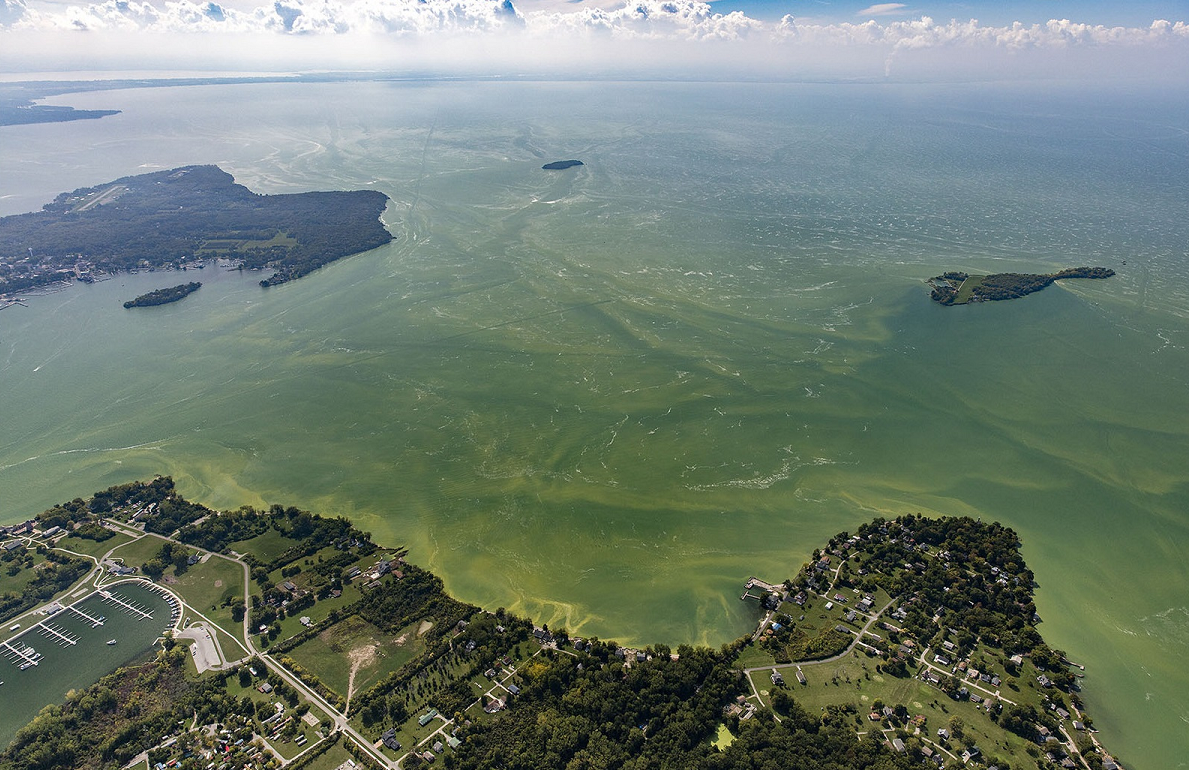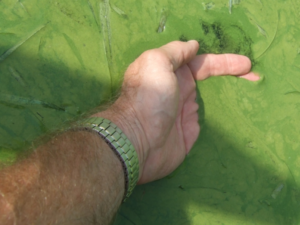
Great Lakes Moment is a monthly column written by Great Lakes Now Contributor John Hartig. Publishing the author’s views and assertions does not represent endorsement by Great Lakes Now or Detroit Public Television.
In hockey, the Habs are the players and fans of the Montreal Canadiens. The name is believed to be an abbreviation of les habitants – the informal name given in the 17th century to the original settlers of New France.
In the Great Lakes region, HABs is well-known as the shorthand for harmful algal blooms, colonies of simple plants called algae that grow out of control and produce toxic or have harmful effects on people, fish, shellfish, mammals and birds. Human illnesses caused by HABs, though rare, can be debilitating or even fatal.
Over the past two decades there has been a re-emergence of regular HABs in Lake Erie due to increasing phosphorus loadings, mainly from runoff from agricultural lands. A bloom of the cyanobacterium Microcystis in August 2014 resulted in a “Do Not Drink” advisory in the city of Toledo for two days due to levels of the toxin microcystin in finished drinking water that exceeded guidelines for safety recommended by the World Health Organization.
The HAB forecast conducted by the National Oceanic and Atmospheric Administration and its partners has shown that HABs in nine of the past 12 years were deemed severe based on its severity index. Through the Canada-U.S. Great Lakes Water Quality Agreement, the Canadian and United States governments have jointly agreed to reduce phosphorus loadings to the lake in order to control the severity and geographic extent of the HABs.
But aside from the health and environmental cost, there’s an economic cost borne by citizens on both sides of the border.
A recent study titled “Estimating the economic costs of algal blooms in the Canadian Lake Erie Basin” published in the July issue of the journal Harmful Algae quantified the costs of HABs in the Canadian portion of the Lake Erie basin. The study was a collaboration between economists and Environment and Climate Change Canada. These researchers looked at the impacts of HABs on six sectors:
- Commercial fishing industry
- Water consumers (water treatment plants and industrial water users)
- Recreational users (boating, fishing, birding, swimming, and hunting)
- Tourism (hotels, restaurants, and travel)
- Property owners
- Non-users
In addition to looking at how HABs impact these six sectors, the researchers estimated economic impacts under two scenarios – do nothing/business as usual and intervening through policy and management actions.
The findings of this study show that HABs will result in annual costs of $272 million (Canadian) in 2015 prices over a 30-year period if we do nothing and continue with business as usual.
Economists define market costs as the total costs of delivering goods and services to customers and they define non-market costs as the costs people are willing to pay for goods and services not traded in the open market like clean water and air and healthy fish and wildlife populations. This study found that the largest market costs will be imposed on the tourism industry ($110 million Canadian in equivalent annual costs) and the largest non-market costs will be borne by recreational users and those who place inherent value on the lake’s quality ($115 million Canadian in equivalent annual costs).
For property owners within 1.2 kilometers (0.75 miles) of the Lake Erie shoreline, this study found that doing nothing would result $712 million loss to the economy and with policy and management intervention that loss would drop to $348 million.
“On the U.S. side, HABs likely have over a $100-million annual impact on Ohio’s economy,” notes Dr. Sam Miller, an associate professor at the University of Notre Dame.
Dr. Bill Mitch, the Spoule Endowed Chair and Director of the Everglades Wetland Research Park in Naples, Florida, is also working on a ten-year research project that is exploring reverting a portion of the Great Black Swamp in northwest Ohio back into wetlands that would filter out farm fertilizers and other nutrients from lake-bound ditches.
The Great Black Swamp was created nearly 20,000 years ago when the last glacier retreated and consists of a million acres of land sprawling diagonally across much of northwest Ohio and into northeast Indiana near Fort Wayne. It has since been largely converted to farmland. Mitch’s idea is to revert 10% of the original Black Swamp or 100,000 acres. This could be phased in over ten years at 10,000 acres per year. Mitch estimates that the cost of this program is $100 million and that it could be phased in over a decade at $10 million a year. The research is still in its preliminary stages.
Advocates are also looking at new ways to combat this problem. In February 2019, Toledo citizens passed the Lake Erie Bill of Rights, which gives the lake the right to “exist, flourish, and naturally evolve” and awards citizens the right to a “clean and healthy environment.” They join a growing movement – referred to as Rights of Nature – providing legal personhood to natural entities.
Such economic studies provide compelling rationale for moving forward with management actions to reduce phosphorus loadings to minimize long-term costs of HABs. However, we must also remember that solving this problem will take all watershed stakeholders working together and recognizing that we all live in a watershed ecosystem and what we do these ecosystems, we do to ourselves.
Featured Image: Harmful Algal Bloom in Western Basin of Lake Erie, Photo by Zachary Haslick via flickr.com cc 2.0
Great Lakes Now Contributor John Hartig is a board member at the Detroit Riverfront Conservancy. He serves as the Great Lakes Science-Policy Advisor for the International Association for Great Lakes Research and has written numerous books and publications on the environment and the Great Lakes. Hartig also helped create the Detroit River International Refuge, where he worked as the refuge manager until his retirement.
2 Comments
-
See also, IJC consultant’s report on economic impacts of Lake Erie algae in Canada and the US: https://legacyfiles.ijc.org/tinymce/uploaded/Publications/Economic-Benefits-Due-to-Reduction-in-HABs-October-2015.pdf
-
It’s greatly misleading to say this is “mainly from runoff from agricultural lands. ” That implies to most people that it is from crop farming, and obscures the fact that much of it is now from CAFOs (concentrated animal feeding operations), mostly the new pig farms helping to feed China.







